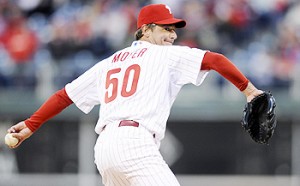
03 May Common Pitching Mistakes
Being someone they are not. The first step for a pitcher who wants to be successful is determining what type of
pitcher they are instead of focusing on what kind of pitcher they wish to be. By this I mean that the pitcher needs to be honest with himself and realize that he has both strengths and weaknesses. Maximizing the strengths and diminishing the weaknesses becomes essential in order to pitch effectively. If a pitcher has poor velocity, trying to throw the ball past hitters like a power pitcher will end in disaster. On the other hand, a pitcher who throws very hard shouldn’t be “nibbling” around the corners of the plate either. This usually ends poorly as well. The baseball culture is fascinated with hard throwers because there are not too many of them in the world. Unfortunately, this inspires young pitchers to try and throw as hard as they can. This of course is a poor game plan for a pitcher with not much velocity to begin with. It all starts with an honest evaluation of your abilities and then creating a strategy to maximize whatever strengths you have.
Too much time between pitches. Is there any trend worse for baseball than the 3 ½ hour game? Not only is it tough for fans, it is tough on players as well. Nobody likes to play behind a pitcher who takes forever in between pitches. Minds wonder, focus is lost, and errors are made. Pitchers can help with this problem by doing one little thing that makes a big difference over the course of a game. Stay on the mound! There is no reason why a pitcher has to throw a pitch, walk halfway to the catcher, receive the throw back, and walk back to the mound. Catchers are more than capable of throwing the ball 60 feet back to you. After the pitch, stay on the mound, receive the throw back, and get right back on the rubber. This accomplishes three things. 1) It conserves energy. The pitcher does not have to waste energy walking back to and up the mound 75-100 times a game. 2) It makes the batter feel rushed which is to the pitcher’s advantage as well. 3) It keeps the fielders attentive because they do not have as much time to let their minds drift between pitches. Less errors are usually the result. Of course, there will be instances when a pitcher should take a little more time after a pitch to gather thoughts and make adjustments. However, it should not become a habit.
Straying from their line. One thing many pitching coaches do to help young pitchers is to draw a line on the mound
that extends from the middle of the pitching rubber down towards the catcher. This is usually done to help the pitcher see, in relation to the line, where his foot lands when he strides towards home to throw. For a right handed pitcher, his foot should land slightly to the right of that line. The opposite is true for left handers. Although this “line in the dirt” trick is a good one, there is more that can be seen by using this line. Instead of just focusing on where his foot lands in relation to the line a player should work to keep his center of gravity on that line from start to finish. Think of someone throwing a dart. Good dart throwers hold the dart up, take the dart back in a straight line, take their hand forward on that same line, release, and continue moving their hand on that line for a few inches even though the dart has left their hand. Basically, they stay on that line from start to finish. The same holds true for accurate pitchers. From start to finish, a pitcher’s center of gravity stays on the line. If a pitcher strays from that line, the ball usually is thrown off that line as well. Ball one. From the wind-up, many young pitchers deviate from that line immediately by stepping to the side. This shifts their weight off that line. When they bring their knee up their weight often shifts across to the other side of that line. The pitcher zig-zags on both sides of that line making it tougher for him to keep the thrown ball on the line. Staying on that line as much as possible from start to finish usually means the ball stays on that line to the strike zone.
Throwing like a position player. At all the levels below college, the majority of pitchers also play other positions. In fact, most of the throwing they do is probably associated with a position other than that of pitcher. This poses a big
problem for many young pitchers that have not yet focused 100% of their attention on pitching like practically all pitchers in college and the professional ranks are forced to do. The problem is that many young players do not differentiate between throwing as a position player and throwing as a pitcher. When they step on the mound, they continue to throw like a position player. In the photo to the right, David Wright throws and finishes tall. He does this because a position player has to make throws that carry over the entire infield or outfield. They are also taught to throw around chest height for it to be easily caught. A pitcher on the other hand only throws 60 feet and wants the ball to end up at knee level most of the time. Therefore, a pitcher must follow through differently to get the ball down in the strike zone. They have to get much more “extension” in their follow through and finish low like Tim Lincecum (photo above) in order to accomplish this. If a pitcher throws like a position player, they generally finish too tall and the ball comes up in the strike zone making it more easily hit. When pitchers step on the mound, they have to remember to throw like a pitcher, not a position player.







